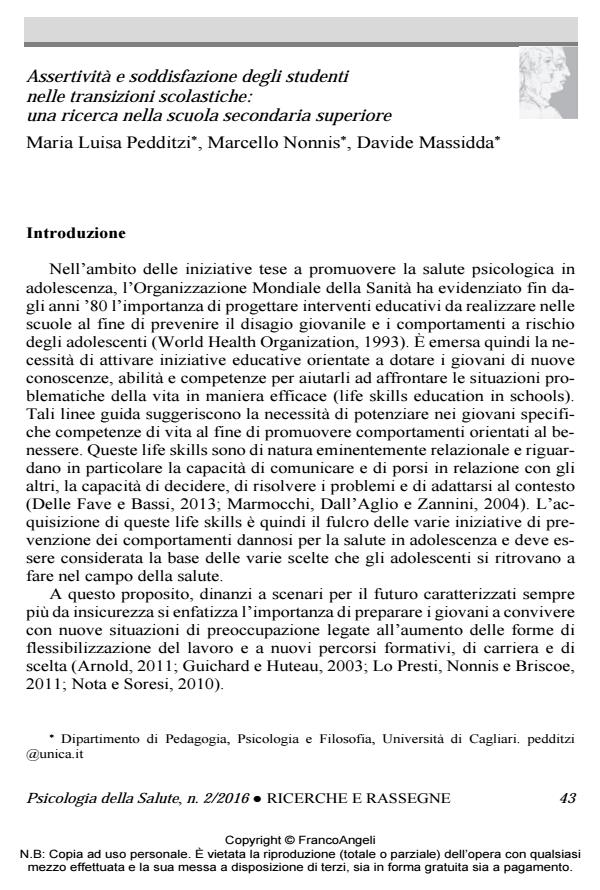Social competence and students’ satisfaction in school transitions: a research in secondary schools
Journal title PSICOLOGIA DELLA SALUTE
Author/s Maria Luisa Pedditzi, Marcello Nonnis, Davide Massidda
Publishing Year 2016 Issue 2016/2
Language Italian Pages 20 P. 43-62 File size 292 KB
DOI 10.3280/PDS2016-002003
DOI is like a bar code for intellectual property: to have more infomation
click here
Below, you can see the article first page
If you want to buy this article in PDF format, you can do it, following the instructions to buy download credits

FrancoAngeli is member of Publishers International Linking Association, Inc (PILA), a not-for-profit association which run the CrossRef service enabling links to and from online scholarly content.
The present study investigates the relationship between assertiveness and satisfaction of students in school transitions in and out of the secondary school. Method. 250 high school students (first and fifth classes) completed the questionnaires: "Come mi comporto con gli altri" [How do I behave with others?] and "La Mia vita da Studente" [My life as a student] (Soresi and Nota, 2003). Through path analysis a model was tested designed to evaluate the influence of factors related to assertiveness on students’ satisfaction Results. Some model paths differ significantly depending on the relative school transition: among first-class students some social skills (eg. expressing disagreement, having social initiative) influence satisfaction in the relationship with peers, while among fifth-class students these social skills affect satisfaction with regards to school experience and the awards received. Moreover, for fifth-class students facing post-degree choices, accepting and manifesting one’s own limitations can lead to lower levels of satisfaction in the relationship with family members. In any case, among the students examined, the frequency in asking for help and support is a good predictor of overall satisfaction. Conclusions. The study suggests that actions of satisfaction promotion should be differentiated according to age and relative school transition
Keywords: Assertiveness, satisfaction towards quality of life, school transition.
- Motivation to Donate, Job Crafting, and Organizational Citizenship Behavior in Blood Collection Volunteers in Non-Profit Organizations Marcello Nonnis, Davide Massidda, Claudio Cabiddu, Stefania Cuccu, Maria Luisa Pedditzi, Claudio Giovanni Cortese, in International Journal of Environmental Research and Public Health /2020 pp.934
DOI: 10.3390/ijerph17030934 - Mentalizing Emotions and Social Cognition in Bullies and Victims Maria Luisa Pedditzi, Roberta Fadda, Tricia Striano Skoler, Loredana Lucarelli, in International Journal of Environmental Research and Public Health /2022 pp.2410
DOI: 10.3390/ijerph19042410 - Psychological Well-Being and Self-Efficacy for Self-Regulated Learning Maria Luisa Pedditzi, Laura Francesca Scalas, in International Journal of Environmental Research and Public Health /2024 pp.1037
DOI: 10.3390/ijerph21081037 - School Satisfaction and Self-Efficacy in Adolescents and Intention to Drop Out of School Maria Luisa Pedditzi, in International Journal of Environmental Research and Public Health /2024 pp.111
DOI: 10.3390/ijerph21010111 - Self-efficacy in life skills and satisfaction among adolescents in school transitions Maria Luisa Pedditzi, Marcello Nonnis, Roberta Fadda, in Journal of Public Health Research 22799036231211420/2023
DOI: 10.1177/22799036231211420 - Pre-service Teachers' Representations About Children's Learning: A Pilot Study Maria L. Pedditzi, Marcello Nonnis, in The Open Psychology Journal /2020 pp.315
DOI: 10.2174/1874350102013010315 - School Social Context, Students’ Self-Efficacy and Satisfaction in High School Maria Luisa Pedditzi, Passarelli Marcello, in The Open Psychology Journal /2018 pp.249
DOI: 10.2174/1874350101811010249
Maria Luisa Pedditzi, Marcello Nonnis, Davide Massidda, Assertività e soddisfazione degli studenti nelle transizioni scolastiche: una ricerca nella scuola secondaria superiore in "PSICOLOGIA DELLA SALUTE" 2/2016, pp 43-62, DOI: 10.3280/PDS2016-002003